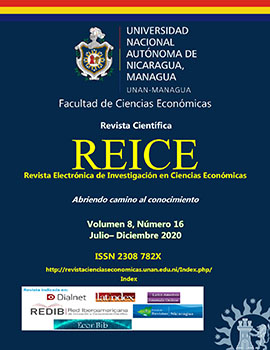Organizational and Technological Modeling of Industrial Facility Redeployment
DOI:
https://doi.org/10.5377/reice.v8i16.10664Keywords:
Redeployment of industrial facilities, Scientific and technical renovation substantiation, Redeployment of industrial areas, Urban deployment, Construction controlAbstract
Redeployment of industrial facilities allows companies to optimize their structure while also creating a competitive environment in the service sector. In addition, during the redeployment process, the property complex undergoes optimization. Because of releasing production, the costs could be reduced by preserving, selling, and leasing production space. However, to achieve and strengthen long-term competitiveness, companies are forced to adjust their activities with an emphasis on the changing demands of the period. Since the world is constantly changing, it is very important to respond to these changes expediently and quickly. So far, international practice and experience of redeployment in the Russian Federation have shown that it is one of the most difficult managerial tasks. During this process, many restrictions and unique characteristics of the company, where they are implemented, should be considered. Consequently, it must be performed only in the presence of the clearly defined goals, redeployment concept, and an understanding of each stage and the methods to be observed. This is a relevant study because the model of the work performed during redeployment allows this process to go as smoothly and efficiently as possible allowing the company to adapt to new market conditions. However, the topic of the study is poorly covered nowadays. In fact, many sources consider a redesigning strategy only as a special case study of a restructuring strategy or a strategy for updating the fixed assets. Therefore, regulatory documentation for capital construction projects as well as redeployment facilities should be improved
Downloads
622
References
Abramov, I. (2019). Formation of integrated structural units using the systematic and integrated method when implementing high-rise construction projects. HRC 2017 (HIGH-RISE CONSTRUCTION-2017) E3S Web of Conferences, 2018, 33, 1-7.
Abramov, I., Poznakhirko, T., Sergeev, A. (2016). The analysis of the functionality of modern systems, methods and scheduling tools. MATEC Web Conf, 86, 1-5.
Ginzburg, A. (2016). Sustainable building life cycle design. MATEC Web of Conferences. XV International conference «Topical problems of architecture, civil engineering, energy efficiency and ecology», 02018.
Graham, P. (2003). Building Ecology: First Principles For A Sustainable Built Environment. Blackwell Science, 76.
Lapidus, A. (2014). Integral potential effectiveness of organizational and technological and managerial decisions of building object. Applied Mechanics and Materials, 584-586, 2230-2232.
Lapidus, A., Abramov, I. (2018). Formation of production structural units within a construction company using the systemic integrated method when implementing high-rise development projects. E3S Web of Conferences, 33.
Lapidus, A., Topchiy, D. (2019). Formation of Methods for Assessing the Effectiveness of Industrial Areas’ Renovation Projects. Proceedings of the IOP Conference Series: Materials Science and Engineering, 471, 1-6.
Lapidus, A.A., Govorukha, P.A. (2015). Organizational and technologic potential of setting of enclosing structures for residential buildings. International Journal of Applied Engineering Research, 10(20), 40946-40949.
Meneyluk, A.I., Lobakova, L.V. (2016). Methodology for choosing effective models for the implementation of buildings reprofiling projects. Bulletin of the Kharkov National Technical University. Series: Management Strategy, Portfolio Management, Programs and Projects, 1, 76-81.
Newton, S. (2016). The Being of Construction Management Expertise. Construction Management and Economics, 34, 7–8.
Oleynik, P., Sinenko, S., Zhadanovsky, B., Brodsky, V., Kuzhin, M. (2016). Construction of a complex object. MATEC Web of Conferences. 5th International Scientific Conference «Integration, Partnership and Innovation in Construction Science and Education», 4059.
Pezeshki, Z., Ivari, S.A.S. (2018). Applications of BIM: A Brief Review and Future Outline. Archives of Computational Methods in Engineering, 25(2), 273–312.
Pukhkal, V.A., Mottaeva, A.B. (2018). FEM modeling of external walls made of autoclaved aerated concrete blocks. Magazine of Civil Engineering, 81(5), 203-212.
Roodman, D.M., Lenssen, N.K., Peterson, J.A. (1991). A Building Revolution: How Ecology and Health Concerns Are Transforming Construction. Worldwatchlnst, 67.
Shinri, S., Masamichi, T. (n.d.). Developing environmental load factors for construction materials used in social infrastructure LCA. Enviromental System Research Papers, 38, 185-191.
Surya, B., Saleh, H., Syafri, Ahmad, D.N.A. (2019). Impact and Sustainability of New Urban Area Development in Moncongloe-Pattalassang, Mamminasata Metropolitan. Journal of Southwest Jiaotong University, 54(6). http://jsju.org/index.php/journal/article/view/462
Topchiy, D., Yurgaitis, A., Kravchuk, A., Shevchuk, D. (2019). Controlling methods of buildings' energy performance characteristics. Topical Problems of Architecture, Civil Engineering and Environmental Economics (TPACEE 2018) electronic edition. E3S Web of Conferences.
Volkov, A., Chulkov, V., Kazaryan, R., Fachratov, M., Kyzina, O., Gazaryan, R. (2014). Components and guidance for constructional rearrangement of buildings and structures within reorganization cycles. Applied Mechanics and Materials, 2281-2284.
Volkov, A., Sedova, A., Chelyshkov, P., Titarenko, B., Malyha, G., Krylov, E. (2016). The theory of probabilities methods in the scenario simulation of buildings and construction operation. Research Journal of Pharmaceutical, Biological and Chemical Sciences, 7(3), 2416-2420.
Zhadanovsky, B.V., Sinenko, S.A. (2014). Visualization of design, organization of construction and technological solutions. Computing in Civil and Building Engineering. Proceedings 2014 International Conference, 137-142.
Zueva, D.D., Babushkin, E.S., Topchiy, D.V., Yurgaitis, A.Yu. (2019). Construction supervision during capital construction, reconstruction and re-profiling. MATEC Web of Conferences, 265, 1-8.
Downloads
Published
How to Cite
Issue
Section
License
Copyright (c) Revista Electronica de Investigacion en Ciencias Economicas
The rights to the articles published in REICE are from the journal, in order to be able to manage their best dissemination. However, since the purpose of the same is the dissemination of knowledge, this journal provides immediate free access to its content, under the principle that making research available to the public free of charge, which fosters a greater exchange of global knowledge.
The opinions expressed by the authors do not necessarily reflect the position of the publisher of the publication or of the UNAN-Managua. Its reproduction and distribution is authorized (in any type of support) provided that the following indications are fulfilled:
- The authorship of the work
- Indicate its origin (REICE magazine, volume, number and electronic address of the document)

